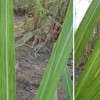Abstract
Mosaic’s most distinctive symptom is a pattern of contrasting shades of green, often islands of normal green on a background of paler green or yellowish chlorotic areas on the leaf blade. It had not been a problem in Florida until 1996, when it was observed on CP72-2086, a major commercial cultivar, near the intersection of Hatton Highway and US 98. Presently, because of the limited acreage of CP72-2086, the disease is only a potential threat. This revised 3-page fact sheet was written by P. Rott, J. C. Comstock, R. A. Gilbert, and H. S. Sandhu, and published by the UF Department of Agronomy, March 2015. (Photo: Philippe Rott, UF/IFAS)
References
Grisham, M. P. 2000. "Mosaic." In A guide to sugarcane diseases, edited by Philippe Rott, Roger A. Bailey, Jack C. Comstock, Barry J. Croft, and A. Salem Saumtally, 249-54. Montpellier, France: CIRAD/ISSCT, La Librairie du Cirad.
Handley, J. A., G. R. Smith, and R. M. Harding. 2001. "Current concepts of the taxonomy and variation of sugarcane infecting potyviruses." In Sugarcane pathology, volume II: Virus and phytoplasma diseases, edited by G. P. Rao, R. E. Ford, M. Tŏsić, and D. S. Teakle, 73-81. Enfield, NH: Sciences Publishers, Inc.
Rott, P., E. Fernandez, and J.-C. Girard. 2008. "Mosaic diseases in sugarcane." In Characterization, diagnosis & management of plant viruses. Vol. 1: Industrial crops, edited by G. P. Rao, S. M. P. Kanura, and S. L. Lenardon, 99-110. Houston: Studium Press LCC.

